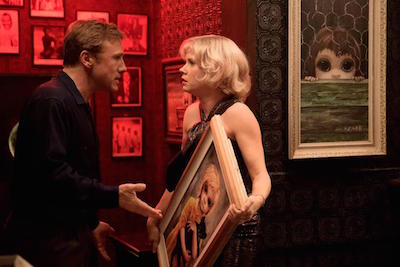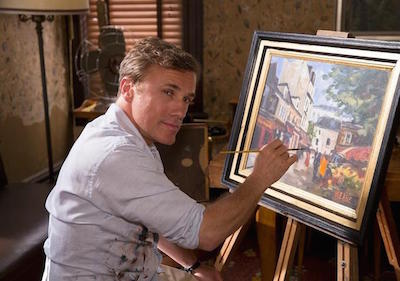 Last week’s national nightmare is over, sort of, as Sony puts The Interview into release–in a few, mostly out of the way theaters, and on a handful or so of balky streaming platforms. That’ll show ya, Kim! Likely to be playing nearer your neighborhood, and unlikely to ruffle the feathers of presumed North Korean cyberterrorists, is Tim Burton’s latest, Big Eyes–a slight, empowerment-oriented biopic no one will be waging war over.
Last week’s national nightmare is over, sort of, as Sony puts The Interview into release–in a few, mostly out of the way theaters, and on a handful or so of balky streaming platforms. That’ll show ya, Kim! Likely to be playing nearer your neighborhood, and unlikely to ruffle the feathers of presumed North Korean cyberterrorists, is Tim Burton’s latest, Big Eyes–a slight, empowerment-oriented biopic no one will be waging war over.
Though suitable for framing in his gallery of his misunderstood artist movies, which also number Edward Scissorhands (1990) and Ed Wood (1994), Big Eyes is the least “Tim Burton” movie Burton has made since his ill-fitting Planet of the Apes remake in 2001. That’s not entirely a bad thing–while I try to revisit the super-“Tim Burton” Batman Returns (1992) and The Nightmare Before Christmas (1993) every holiday season, that trick bag of Gothic tropes has been emptying for years, so stretching is necessary.
But Scott Alexander and Larry Karaszewski, who penned Ed Wood‘s eccentricity-rich script, haven’t given Burton much to work with, in a project they were planning to direct themselves. I like their classical, foursquare approach to their craft–if a character watches Perry Mason on TV for what seems to be no good reason, you can bet that they’ll have a good reason for it by the end. They like real-life oddballs but don’t indulge them. (1996’s The People vs. Larry Flynt and 1999’s Andy Kaufman portrait, Man on the Moon, both directed by Milos Forman, are their other best-known credits.) “Big eyes” artist Margaret Keane, played by Amy Adams, doesn’t have enough kookiness to sustain a movie, however, so the script keeps drifting in the direction of her ne’er-do-well husband, Walter (two-time Oscar winner Christoph Waltz), who supplies too much.
Fleeing a disappointing marriage with her daughter in tow, Margaret makes her way to San Francisco, where beat culture is on the rise. Her specialty is unique: portraiture exaggerating the eyes to a surreal degree. But Margaret, intimidated by the art world, can’t market her vision, and carries on dispiritedly as a commercial artist. Enter Walter, a less talented, yet more flamboyant artist, an older, cosmopolitan ladies’ man with the gift of gab, who steals her heart–then goes for her identity.
 Walter sees the possibilities in his new wife’s art, and wangles an exhibition at the famed hungry i nightclub when a snooty gallerist (Jason Schwartzman) turns up his nose. The unusual if kitschy pictures become the talk of the town in that part of the town that talks about art, and attract the interest of a prominent newspaperman (Danny Huston, who narrates). When they fail to sell, Walter has his brainstorm–anticipating Andy Warhol, he very successfully sells posters of Margaret’s art, touching off a mass marketing sensation. (One that’s still with us: When my son and I take “big eyes” selfies on my iMac, we’re paying homage to the Keanes.)
Walter sees the possibilities in his new wife’s art, and wangles an exhibition at the famed hungry i nightclub when a snooty gallerist (Jason Schwartzman) turns up his nose. The unusual if kitschy pictures become the talk of the town in that part of the town that talks about art, and attract the interest of a prominent newspaperman (Danny Huston, who narrates). When they fail to sell, Walter has his brainstorm–anticipating Andy Warhol, he very successfully sells posters of Margaret’s art, touching off a mass marketing sensation. (One that’s still with us: When my son and I take “big eyes” selfies on my iMac, we’re paying homage to the Keanes.)
There’s one catch: Walter, having convinced the skeptical Margaret that “lady art” won’t sell, takes all the credit for the work. While Margaret can stay up in their garret and paint to her heart’s content, the secrecy becomes a bone of contention for the couple and Margaret’s daughter, who knows little of the ruse. (In a rare Burton touch, she grows up to be a big-eyed teenager, and Margaret, mentally strained, imagines big-eyed shoppers and passers-by on the street.) She reaches her breaking point when Walter, now a high-living celebrity, bamboozles a showcase mural for the United Nations at the 1964 World’s Fair, claiming that the portraits were inspired by war orphans. A powerful New York Times critic (an imperious Terence Stamp) objects, as does Margaret, whose explanation for her work is more prosaic. Humbled, and increasingly alcoholic, Walter takes to throwing lighted matches at Margaret and her daughter (as James Coburn does to Audrey Hepburn in 1963’s Charade); they alight to Honolulu, where Margaret, guided by newfound faith as a Jehovah’s Witness, eventually challenges Walter, more egocentric than ever, for rightful ownership of her art.
 I never predicted a courtroom drama for Tim Burton, yet that’s what Big Eyes becomes in its final stretch, with the judge, upset by Walter’s showboating antics in his own defense, deftly solving a Gordian Knot of issues. He wasn’t the only one frustrated; Waltz, who makes like Dick Van Dyke in the early scenes of charming contrivance, unravels into hammy Great Actor shtick in these scenes, and taking “you can’t take your eyes off him” scenes into the stratosphere I found it very easy to take my eyes off him. While Margaret poses for publicity stills with Adams, Walter died in 2000, and I wondered if a more nuanced view of him was possible.
I never predicted a courtroom drama for Tim Burton, yet that’s what Big Eyes becomes in its final stretch, with the judge, upset by Walter’s showboating antics in his own defense, deftly solving a Gordian Knot of issues. He wasn’t the only one frustrated; Waltz, who makes like Dick Van Dyke in the early scenes of charming contrivance, unravels into hammy Great Actor shtick in these scenes, and taking “you can’t take your eyes off him” scenes into the stratosphere I found it very easy to take my eyes off him. While Margaret poses for publicity stills with Adams, Walter died in 2000, and I wondered if a more nuanced view of him was possible.
Adams doesn’t give you all that much to look at, however. Playing a woman somewhat uncomfortable in her own skin, who finds faith more from without than within, she’s a cipher, and Margaret’s vagueness isn’t solved by her natural, tamped-down appeal. Is it her hair? Other than Michelle Pfeiffer’s Catwoman, blondes don’t have more fun in Burton’s movies; the raven-haired Krysten Ritter, who plays Margaret’s skeptical friend, is more his type, and her scenes have a snap and a focus to them that Adams’ lack. The real problem, though, is that in movies women have been taking this journey toward fulfillment since the 70s, long before the real Margaret filed suit against Walter; the movie compacts a 30-year span of events.
Is Big Eyes a bust? No–it’s absorbing in the moment, and Burton’s usual production team does solid, naturalistic work. (Dark Shadows cinematographer Bruno Delbonnel, who shot the Coen brothers’ wintry Inside Llewyn Davis, drenches as much of the film as he can in a dispelling sunlight, unusual for Burton and San Francisco.) What it lacks is a depth of vision behind its strange painterly surface.





Comments